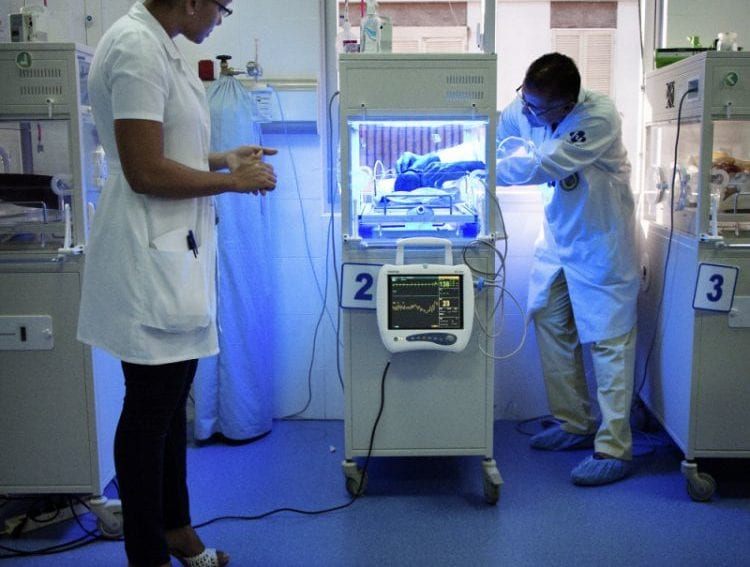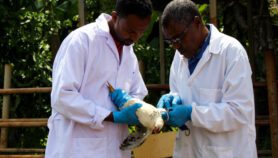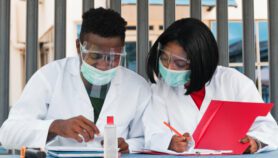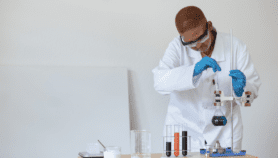By: Linda Nordling
Send to a friend
The details you provide on this page will not be used to send unsolicited email, and will not be sold to a 3rd party. See privacy policy.
Inspiration comes in many forms. To Berhanu Abegaz, executive director of the African Academy of Sciences (AAS), it comes as a bone ten centimetres in length with tiny notches carved into its sides.
The Ishango bone was found in 1960 in Central Africa by a Belgian explorer, and is on display today in a Belgian museum. Scientists say it is the fibula of a baboon, and have dated it to be from 22,000 years ago. [1]
Its age is impressive, but it's the markings that inspired Abegaz. Scientists say the notches are the first evidence of a mathematical understanding beyond mere counting among early humans.
To Abegaz, a chemist with a deep fondness for mathematics, it was the perfect symbol to represent Africa's scientific heritage, and just what he was looking for.
A new alliance
Last week (10 September), a laser-cut glass replica of the Ishango bone was unveiled by Ameenah Gurib-Fakim, president of Mauritius and a chemistry professor to boot, at the formal launch of the Alliance for Accelerating Excellence in Science in Africa (AESA) in Nairobi, Kenya.
“If the alliance is to succeed, it needs to overcome a pattern that has stumped other ambitious African science initiatives.”
Linda Nordling
AESA, which is hosted at AAS headquarters in Nairobi, is intended to bring the centre of gravity for health research funding decision-making from places such as Seattle in the United States and London in the United Kingdom to Africa itself.
Its African backers include the New Partnership for Africa’s Development, a continental policy implementation agency.
Three big international research funders — the UK-based Wellcome Trust, the UK's Department for International Development (DFID) and the Bill and Melinda Gates Foundation in the United States — have earmarked funding programmes that they plan to let AESA administer.
From next year, AESA is expected to take over the management of the Wellcome Trust's five-year US$70 million DELTAS programme, which involves seven new African centres of health research and training excellence in subjects ranging from biostatistics to mental in six African countries: Ghana, Kenya, Mali, South Africa, Uganda and Zimbabwe.
From next year also, AESA is expected to issue and manage the first call for proposals for the Africa Grand Challenges programme. This is part of the Bill and Melinda Gates Foundation's suite of Grand Challenges initiatives aiming to support research and innovation tackling problems hampering global development.
Keeping the momentum
There was a lot of optimism in the air at the AESA launch. The cream of African science policymaking were there, from African Union’s human resources, science and technology commissioner Martial De-Paul Ikounga to Glenda Gray, president of South Africa's Medical Research Council — a major medical research funder in Africa.
“African governments need to put serious money into their research institutes and universities to show AESA’s international backers that they are committed to creating a flourishing science base.”
Linda Nordling
All those present were united in their praise for AESA, and the faith in African science that it represents. However, if the alliance is to succeed, it needs to overcome a pattern that has stumped other ambitious African science initiatives.
International funders have tried to kick-start African excellence before. For instance, the African Union’s Africa Research Grants were launched in 2011 with funding from the European Union. [2] It had grand ambitions of becoming an African version of the European Framework Programmes. But when African governments failed to come to the party with their own funding to supplement the EU’s cash, it lost momentum.
Another initiative that didn’t even manage to get off the drawing board was the African Science and Innovation Fund. This idea appeared in Consolidated Plan of Action for African science, adopted ten years ago by African science ministers.
It was envisaged as a joint pot where international donors could pool their funding for African science, to be managed on the continent. But the African Union struggled to find an institutional home for it, and funders were cold to the idea, and so it was shelved.
African support is key
It is challenging for these initiatives to stay relevant after the hype of the launch dies down. As a representative from a drug company noncommittally said at the AESA launch when asked whether his company would support the alliance: “We'll see. There are so many programmes that we are already working with.”
Obviously, continued support by funders — and not just the Wellcome Trust, DFID and the Gates Foundation, but a range of others — will be essential for AESA’s long-term success. For this to happen, the AESA secretariat will need to manage its grants impeccably to ensure a smooth transition of the decision-making powers to African soil.
Ultimately, AESA's mission is to create conducive environments for research across Africa. Not just in medical and health research, but across all disciplines. Such environments will not be created unless institutional leaders are ready to drive the transformation.
Moreover, African governments need to put serious money into their research institutes and universities to show AESA’s international backers that they are committed to creating a flourishing science base.
In the end it’s about inspiration. A 22,000-year-old arithmetic tool may provide scientists in Africa with a powerful connection to their past. But healthy institutions with solid career paths of the sort that AESA wants to create will give them a future.
Journalist Linda Nordling, based in Cape Town, South Africa, specialises in African science policy, education and development. She was the founding editor of Research Africa and writes for SciDev.Net, Nature and others.
This article has been produced by SciDev.Net's Sub-Saharan Africa desk.
References
[1] Eric W. Weisstein, Ishango bone (Wolfram Research Inc, Web resource accessed 16 September 2015).
[2] David Woods and others Case study: African Union Grants Programme (OECD, accessed 16 September 2015)














